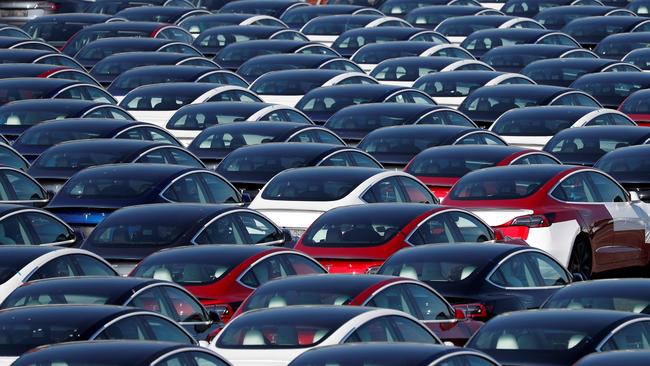BHP says there’ll be 400m EVs speeding on to our roads and that should be a boon for nickel
BHP’s nickel boss has made eye-watering predictions, with the company expecting there to be 400 million electric vehicles on the road by 2030.

The head of BHP’s (ASX:BHP) resurgent nickel division says the world’s biggest miner continues to see nickel-rich battery chemistries as the dominant technology for a global electric vehicle fleet that could exceed 400 million cars by 2030.
Talking at a WA Mining Club lunch on Thursday, BHP Nickel West president Jessica Farrell said the diversified miner continued to expect a massive surge in nickel demand in the coming decade.
She said within only a few years, as much as 26Mt of copper metal and 15Mt of nickel could be needed for the EV market. On our roughly sketched numbers, that’s equivalent to around a year of global copper supply and five years of nickel production.
For the latest mining news, sign up here for free Stockhead daily newsletters
That informs BHP’s decision to invest heavily in the nickel business, including a $1.7 billion project to build a 35,000tpa nickel and 41,000tpa copper mine in the remote Ngaanyatjarra Lands of WA’s Great Victoria Desert, and a rebuild of its Kalgoorlie Nickel Smelter furnace that will include the installation of a 1000 person camp.
Farrell said BHP, which counts auto giants Ford, Toyota and Tesla among its customers, now sold 85 per cent of its product to battery makers, a far cry from less than 10 per cent five years ago.
“Worldwide we expect that three out of five passenger car sales to be electric by 2030, rising to nine out of ten in 2040,” she said.
“In a plausible upside case we also estimate there could be over 400 million electric vehicles on the world’s roads from 2030, up a significant number from today.
“We believe that those vehicles obviously require a significant amount of our metals – 26Mt of copper and 15Mt of nickel to supply that new demand, recognising that also doesn’t include the materials that would be required to charge them.”
Nickel-cobalt-manganese batteries have long been the preferred cathode chemistry of lithium-ion battery producers. But cheaper, shorter range, lithium-iron-phosphate batteries have been grabbing increasing market share.
MORE FROM STOCKHEAD: High hopes for ASX African lithium adventures | Argentina continues to build brine kingdom | Miners ‘cautiously optimistic’ on China
The International Energy Agency says LFP batteries ate up a 27 per cent market share in 2022 of lithium-ion batteries globally, with high and low nickel cathodes combined making up 70 per cent. That’s down from a combined 95 per cent in 2019.
But Farrell says BHP expects nickel demand from batteries to remain strong.
“The dominant battery chemistry powering this global fleet is expected to rely on nickel,” she said.
Decarbonisation and me
BHP produced 80,000t of nickel metal in FY23, up 4 per cent from the year earlier, and is expecting to deliver 77,000-87,000t in FY24.
While it is not the largest producer in the global nickel market, Farrell says BHP sees a competitive advantage in its position as one of the lowest-carbon-intensity producers on the market.
“At Nickel West we acknowledge it’s not just about producing the raw materials for a decarbonising world, but it’s also how we thrive and how, too, we must decarbonise,” she said.
“We have one of the lowest production carbon emission intensities of benchmark nickel producers globally, but we still have big plans to reduce our operational greenhouse gas emissions and seek to deliver even greater value to our customers.
“Over half of our carbon emissions are from our electricity consumption, so reducing scope 2 emissions is a very high priority.”
Its southern system – including the Kambalda concentrator, Kalgoorlie Smelter and Kwinana refinery and sulphate plant – could be capable of being powered entirely by renewables for a 24-hour period by the end of 2024 with the development of a 50MW solar farm in Merredin and 75MW wind farm at Flat Rocks in Kojonup, backed by BHP power purchase agreements.
“We have initially entered a 12-year power purchase agreement with Enel Power for 100 per cent of the energy produced at Flat Rocks and (it) is expected to reduce our Scope 2 emissions at Nickel West by 32 per cent and overall emissions by 16.5 per cent,” Farrell said.
BHP is also bringing two solar farms online at its Northern Operations at Mt Keith and Leinster, installing 70,000 solar panels across 90ha which will cut northern ops scope 2 emissions by 12 per cent and overall emissions by 5 per cent.
Farrell also said she was happy to see funding for the modernisation of the South West Interconnected System in the WA state budget.
Upgrading the major electricity network in the state would support “increasing demand and greater connection pathways”, Farrell said.
Visit Stockhead, where ASX small caps are big deals
A critical mineral
While it may not seem it, nickel supply is growing rapidly this year … in Indonesia.
Prices briefly hit almost $US50,000/t last year (and controversially to more than $US100,000/t for a period of time equal to Bob Hawke downing a pint), but in the absence of the short squeeze that prompted that moment of insanity last year are back in the low $US20,000s.
That is decent by historical standards, but maybe not high enough to incentivise the amount of new nickel projects needed in the West to support the energy transition.
One thing which many nickel explorers have been calling for is its inclusion in Australia’s 26-strong list of critical minerals, which could mean government funding for new projects prioritised and new pathways open for nickel companies for grant and loan support programs.
It comes amid a tidal wave of government initiatives worldwide to incentivise production of commodities seen as key to the rollout of electric vehicles and reduction of carbon emissions.
Nickel was included on the US list two years ago, even though its supply is more diverse and not as prone to supply disruption as commodities such as lithium, tin and graphite.
The Australian government opened consultations yesterday for the rebuilding of the critical minerals list. Asked if BHP had lobbied for nickel’s inclusion, Farrell said it had been involved in discussions, but was muted on the impact that could have on Nickel West.
“Obviously we see in BHP nickel as a future facing commodity, we certainly see it as a mineral that is absolutely required in the future,” she said.
“We’ve been active in the discussions on the round tables and the discussions on critical minerals and metals in Australia and see that it absolutely makes sense to continue on that trajectory.
“It doesn’t change what we will do with the asset and our views going forward.”
This content first appeared on stockhead.com.au
SUBSCRIBE
Get the latest Stockhead news delivered free to your inbox. Click here


